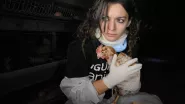Photographer Sana Ahmadizadeh, a worthy winner of Slideluck Editorial grant for Everything is Connected, takes us on a personal journey of an environmental migration from the south to the north of Iran. She documents so poetically the current environmental crisis of Iran’s southwesterly province of Khuzestan that has gone from wetland to wasteland. A Place to Live allows us to travel with her from her hometown of Ahvaz through a series of compelling images that highlight politics and pollution in a graceful manner.
Just for a moment, we see a warm, golden mist deceptively drenched in her images that can be mistaken for humidity and moisture in the air. However, there is a cold harsh reality attached to photographs as we come to learn that they are in fact dust storms. The grey darkness in Dark Caspian Sea reads like a rain storm about to take place, but there is no rain, just dust. These storms are a direct result of the drying out of rivers and hectares of wetlands given away for oil extraction. Khuzestan was best known as Iran’s oil-rich province, but it also lays in the fertile crescent of the Middle East, on some of the earth’s best water and land. It provided the area natural resources for agriculture from it’s numerous large rivers and was home to some of the earliest human civilizations. Nevertheless, this landscape has now changed as the rivers die out; this once populated area is now becoming a ghost town as people flee this once fertile land.
The lack of moisture in drying plains allows dust to rise before winds carry it away; as a consequence, Sana carries the emotions of sorrow, fear and pain from the loss and destruction of her environment. She too, has had to leave her land due to her severe respiratory problem, a persistent illness from the effects of the environmental crisis in Ahvaz. Through this crisis, Sana relives a similar journey and feeling of displacement to that of her mother when she fled her hometown to take refuge up north from the Iran-Iraq war.
This Story is about my emotions and relationships with the environment and not merely connected with pollution and environmental issues it also brought back the memories of another life where I had the same experience and feelings that my mother had when she was an adolescent and reminds me two generations of displaced people. Two narratives with their own fears and sorrows.

Sana not only addresses the relationships with the environment through her series of photographs, but also the relationship with the Iranian government which insists the dust storms originate from outside of the country, yet the department of the environment concludes that this dust comes from Iran. Additionally, a post-war water policy in Khuzestan allowed for several dams to be built, which further depleted waterbeds and wetlands. These dust storms are connected to overlapping issues, some which extend beyond Iran’s borders, which are tied together in climate change and global warming. Pollution of air and water has contributed to long-term changes in weather.
Policy makers have aggravated the consequences from external influences such as plantations of sugarcane, a crop not native to the region that consumes large amounts of water. Water contamination, soil erosion and loss of biodiversity have been the after effects of this outside influence.
Furthermore, oil companies outside of Iran came in just after the war with Iraq to find oil, this lead to burning and bulldozing of wetlands and plant species. The destruction of these environments are undoubtedly linked to the dust storms. The drying out of rivers and wetlands in Khuzestan has changed the natural fabric in a way the Iran-Iraq war never did.

A Place to Live questions whether the extensive damages to the regional and outer landscape of Khuzestan can be reversed from barren deserts and marshlands back to the lush farmlands and orchards that once were, for people to make their way back home.
Sana is an Iranian social documentary photographer and focuses more on her own personal work. She is a graduate of Nanophysics from Chamran University of Ahvaz. She lives and works in Iran. Sana’s work explores social issues and everything related to human beings.






